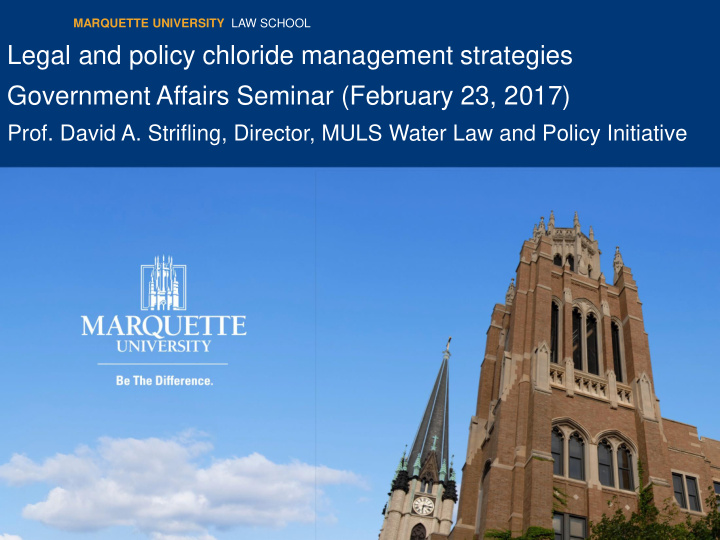



MARQUETTE UNIVERSITY LAW SCHOOL Legal and policy chloride management strategies Government Affairs Seminar (February 23, 2017) Prof. David A. Strifling, Director, MULS Water Law and Policy Initiative
MARQUETTE UNIVERSITY LAW SCHOOL Chloride trends, nationwide
MARQUETTE UNIVERSITY LAW SCHOOL Interdisciplinary project approach Conduct literature review to understand extent and causes of the problem Identify and develop potentially responsive legal and policy options Analyze options using various metrics
MARQUETTE UNIVERSITY LAW SCHOOL Summary of literature review • Health and environmental impacts of elevated chloride concentrations include adverse effects on ecosystems and degraded water quality • Elevated chloride concentrations are observed during all seasons (max. in winter months), and are highly correlated with impervious surfaces • About half of chloride applied as road salt enters aquifers before next salting period, but chloride input continues during non-snowmelt periods due to retention in groundwater and soils • Elevated chloride concentrations persist in watersheds for many decades (40-70 years is a reasonable estimate)
MARQUETTE UNIVERSITY LAW SCHOOL Summary of literature review • Relative impacts of various chloride sources are localized. Deicing and Water Other Other or Study author Year related runoff softener use industrial background Madison, Wisconsin Metropolitan 2015 7% 57% 18% 18% Sewerage District Twin Cities Data from 72.5% from wastewater treatment facilities, 27.5% Metropolitan 2000-2007 collectively Area State of New 2013 96% 2% Not reported 2% Hampshire
MARQUETTE UNIVERSITY LAW SCHOOL Responsive policy options developed Incentivized Information self- dissemination governance Direct Chloride regulatory alternatives strategies Integrated Direct watershed economic management measures
MARQUETTE UNIVERSITY LAW SCHOOL Incentivized self-governance • Example: New Hampshire program provides certification after training on best practices in exchange for snow- and ice-related liability waiver • Advantages: forces efficiency while balancing environmental and safety concerns; cost reduction due to decreased salt usage; marketing advantages; potential insurance benefits • Challenges: maintaining funding, voluntary nature of program, difficulty of initial passage, and potential for legal challenge • Results: salt use decreasing by average 30%, per annual report, with corresponding cost savings; and intensive monitoring in chloride-impaired watersheds shows environmental improvements • Hundreds of participants certified
MARQUETTE UNIVERSITY LAW SCHOOL Information dissemination – Strategies for the public-at-large (SaltWise) • Attempts to educate the public about deicer usage levels and effects on human health and the environment – Strategies for chloride users • Optimize private water softener usage • Replace older or inefficient softeners
MARQUETTE UNIVERSITY LAW SCHOOL Direct regulatory strategies – Regulations setting best practices for salt application are rare, while regulations setting best practices for salt storage are more common – Regulation of salt trucks as point sources under Clean Water Act (legally possible but practically unlikely) – Sewer use ordinances – Best Management Practices could include • Alternative chemicals • Road/Weather Information Systems • Anti-icing/pretreatment methods • Uniform spreading rates, timing, and equipment Deicing application guidance, 24 degrees and light snow Minnesota 80-120 lb/lane mile, depending on conditions New Hampshire 250 lb/lane mile Wisconsin 100-300 lb/lane mile
MARQUETTE UNIVERSITY LAW SCHOOL Chloride alternatives • Green infrastructure - reduces and treats storm water at its source while delivering environmental, social, and economic benefits – Permeable pavements, bioswales, and related technologies can reduce pollutant loads by over 90% – Resulting cost savings of 15-80% (reduces cost for “gray” infrastructure and road salt application) – NH study finds permeable pavement reduces salt application requirements by 75% because water does not pool on the surface – Challenges include associated costs, public resistance, and potential to transfer chloride to groundwater • Use of alternative deicers
MARQUETTE UNIVERSITY LAW SCHOOL Integrated watershed management – Promotes coordinated development and management of water and related resources to maximize economic and social welfare without compromising ecosystem sustainability – Multiple agencies/jurisdictions work together in a watershed or region to address a broad range of water issues – Spectrum of approaches including information sharing, informal planning, and shared management – Advantages: broad, inclusive process is flexible and allows for adaptive management. Can complement traditional approaches and provide incentives for compliance. – Challenges: funding, inertia, legal roadblocks
MARQUETTE UNIVERSITY LAW SCHOOL Direct economic measures – Supply and demand; cost drives use rates – Politically unpalatable – Some innovative alternatives exist – Alternative proposals (Iowa) • Minimal (1%) increase in state sales tax • Apply portion of the proceeds to water infrastructure and related water quality protection measures • Tie together water quality and school infrastructure • Iowa: would generate about $4.7 billion for water quality improvements between 2017 and 2049 • Alternative: fund water quality programs out of a water metering tax that currently generates about $28 million to state’s general fund annually
Recommend
More recommend